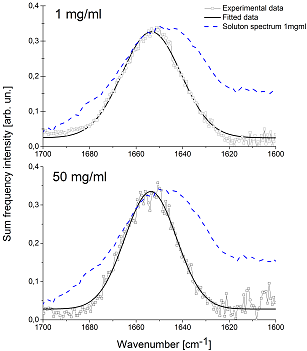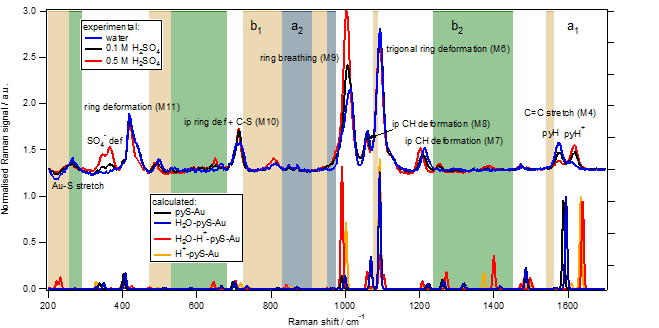Spectroscopy portfolio
Sum frequency spectroscopy
Sum frequency spectroscopy is a widely applicable spectroscopy to gain vibrational spectra of molecules at interfaces. It has been used for the study of catalyst surfaces, biological and synthetic membranes, biomedical materials, surface coatings, nanostructures and –particles, emulsions and many more. Unlike standard vibrational spectroscopies such as FTIR or Raman, the optical selection rules involved in SFS mean that only molecules at interfaces generate a spectrum. Moreover, SFS can tell whether a molecule points “up” or “down” at an interface and determine its absolute configuration in space in detail.

Amide I spectra of insulin at the air-water interface in comparison to solution FTIR spectra.
Second harmonic generation
We are using second harmonic generation for detection of metal fatigue, which creates dislocations in the material, which in turn alter the electronic density of states. With the help of polarisation measurements, we can determine the tensor components of the second order susceptibility tensor.

Polarisation scans with initial p+s polarisation on pre-fatigued titanium.
Surface enhanced Raman Spectroscopy
Surface Enhanced Raman spectroscopy is a widely used technique to enhance the weak Raman scattering of molecules by surface plasmon excitation. This mostly enhances the z-component of the local electric field, which simplifies the resulting molecular spectra and allows to determine the local symmetry of the adsorbate.

Surface enhanced Raman spectra of 4-mercaptopyridine adsorbed on rough gold in comparison to DFT calculations. The background is coloured according to the symmetry of the mode (with reference to the C2v symmetry of the pyridine ring).
